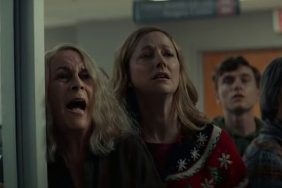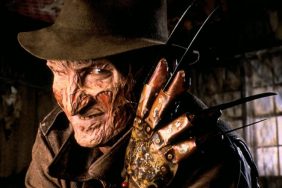Each week, Terror Cult singles out a singularly perverse facet of the horror genre to be explored, catalogued, and eviscerated before the very eyes of CraveOnline’s hapless and bemused readership. This week, we explore the rise of the ‘80s slasher film, noble ancestor of the modern era’s straight-to-VOD “torture porn” glut.
Though it has clear relatives and antecedents from overseas (the Italian giallo, most notably), the slasher film is a more or less uniquely American subset of the horror and gore tradition. Starting in the mid-‘70s with movies like Bob Clark’s Black Christmas, and picking up steam toward the end of the decade, the slasher subgenre crested in the 1980s with a floodtide of bare-breasted, blood soaked, colorful rehashes of the same basic, no-fail storyline. Codified in the late ‘90s by Kevin Williamson’s Scream franchise, golden age slasher movies typically revolve around an isolated group of friends, acquaintances, or strangers who find themselves suddenly assailed by the wrath of a merciless killer hell bent on brutally eviscerating anyone and anything crossing his or her path. Slasher movies routinely feature rivers of gore, typically at least a few naughty sex scenes, and an overall attention to healthy one-upsmanship when it comes to literal and figurative creative execution.
Several factors played into the rise of the slasher genre during the dawn of the 1980s, the main one being the arrival of VHS, and the consumer rental market that resulted. Starved for content to offer their customers, fledgling video rental stores were willing to purchase almost any variety of cheap product readily available with which to stock their shelves. Because low-budget, formulaic horror movies were so cheap and fast to produce, they became a highly attractive option for filmmakers looking to turn a fast dollar. The initial lack of censorship regulations for VHS, and the subsequent cheap publicity that resulted from early censorship efforts such as Britain’s “Video Nasties” list, made the genre even more high-demand and profitable.
Examples of golden age stalk-and-slash are too numerous to fairly summarize, but the examples below should give a general idea for newcomers, and a nostalgic rundown for old hands, of the full range of goofy, bizarre, surreal, and sometimes actually hair-raising entries that fall under the classic age slasher film header.
The Toolbox Murders (1978)

A bit slow by today’s standards, but nonetheless unforgivingly brutal and laced throughout with sleazy, gratuitous full frontal shots, Toolbox Murders was part of a crossover wave of 42nd Street grindhouse horror movies that bled over into the emerging VHS market, unexpectedly lengthening and expanding their ultimate hold on the public consciousness. Like Driller Killer, Nightmares in a Damaged Brain, and several other early slasher films, Toolbox Murders was a video nasty, helping to secure its enduring place in the pantheon of sleazy, gory splatter operas.
Savage Weekend (1979)

One of the first wave of knockoffs after the success of Black Christmas and other early attempts, Savage Weekend follows a group of clueless weekenders beset by a psycho in a rubber mask. The movie features character actor and genre favorite William Sanderson, playing a variation of the generic backwoods hick role that endlessly defined his career. Aside from an oddly progressive portrayal of a gay character, a hilariously melodramatic divorce subplot, and Sanderson’s always endearingly twitchy delivery, Savage Weekend is unfortunately too dry and chaste for its own good, more rife with tasteful cutaways than with lurid voyeurism. It’s noteworthy, however, for helping to cement genre tropes like the masked stalker, and the later bait-and-switch red herring routine that such disguises can often cheaply afford.
Prom Night (1980)

Featuring Jamie Lee Curtis, whose role in the genre-defining Halloween and Halloween II have secured her iconic genre status through to the present day, Prom Night was one of a slew of holiday-themed slashers that burst onto the scene following Halloween’s critical and commercial success. Prom Night combines the slow-build suspense of Carpenter’s Halloween with a knock-off plot borrowed from Carrie about snotty popular kids attempting to exercise petty vengeance against a rival in the form of staged public humiliation.
Terror Train (1980)

Released the same year as Prom Night and once again featuring Curtis in a lead role, Terror Train also boasts a suspiciously similar plot, involving a masked killer seeking years-old revenge against a group of pranksters whose antics went tragically awry. It also has the gimmick of being set entirely inside a moving train on New Years Eve, making for a manageably small collection of cheap sets augmented by garish and skimpy theme costumes. The movie also features a weird and memorable appearance by magician David Copperfield.
Sorority House Massacre (1986)

A video store perennial for years, Sorority House Massacre banks on a convoluted backstory about suppressed memories and is loaded with bleeding dolls, bleeding photographs, and other surreal dream imagery. It’s also loaded with nudity, although unfortunately it lacks the sexual shamelessness displayed by many similar genre films from the second half of the decade.
The Slumber Party Massacre (1982)

It doesn’t always successfully play as one, but Slumber Party Massacre is notable for being conceived as a Feminist parody of the slasher genre rather than a rote exercise. Its screenplay was written by noted radical feminist author Rita Mae Brown, and was directed by Amy Jones, screenwriter of Mystic Pizza. Its satire isn’t incisive or consistent enough to penetrate the genre’s clichés as deeply as they truly deserve, but its flourishes of humor and brazenly tongue-in-cheek approach to female sexuality are charming regardless.
Eyes of a Stranger (1981)

Deriving as much from the murder mystery tradition as from the slasher tradition per se, Eyes of a Stranger follows a female reporter determined to solve a string of violent sex murders occurring in and around her apartment building. The movie features gore effects by genre celebrity Tom Savini, as well as a very early performance from Jennifer Jason Leigh, who plays the protagonist’s deaf, blind, and mute little sister, and who gets to close out the film with a very dramatic, partially-nude climactic shoot-out.
The Town That Dreaded Sundown (1976)

An early but mostly middle-of-the-road entry, Town that Dreaded Sundown is set in a small town in Texas in the 1950s and is ostensibly based on a true story about a serial killer preying on teenagers at lover’s lane. Its most memorable scene is a truly bizarre, borderline surreal murder involving forced outdoor bondage and the violently obscene, wholly gratuitous use of a trumpet.
The Driller Killer (1979)

Set in the seedy underworld of New York’s DIY artpunk scene, The Driller Killer was director Abel Ferrara’s first non-porn feature, and features Ferrara himself in a starring role as a temperamental painter turned schism-brained psychopath. Driller Killer is gritty, bleak, and occasionally hilarious, riffing on prior genre send-ups of pretentious scenesters like Roger Corman’s A Bucket of Blood and H.G. Lewis’ Color Me Blood Red.
Curtains (1983)

Curtains stars John Vernon and Samantha Eggar, who is best remembered by horror fans for her pustule-encrusted, bugnuts crazy starring role in Cronenberg’s The Brood. In this film, Eggar plays a shunned actress left to rot by her deceitful director and implicit lover in a mental asylum so he can audition a series of young ingénues for a role that was originally supposed to be hers. Eggar is just as captivatingly nutty in this film, which is a little uneven and suffers from an oddly abrupt and confusing twist ending, but it’s weird enough overall to still be a good time.
Come back next week to experience an all new Terror Cult, replete with more sick, sad and twisted ruminations on the many dark and twisted annals of the horror genre.








